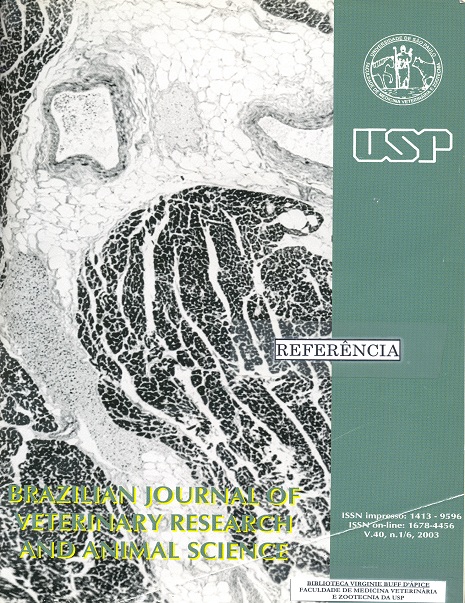Morphological study of equine flexor tendons
DOI:
https://doi.org/10.1590/S1413-95962003000200005Keywords:
Equine, Morphology study, TendonAbstract
The objective of the present study was to describe the normal appearance of the superficial (SDFT) and deep (DDFT) digital flexor tendons of horses and to focus on the differences between their histological constituents. Morphological study was performed on the four tendon segments collected from the thoracic and pelvic limbs of seven fresh cadavers of adult horses without previously diagnosed clinical lesions. The segments analyzed were the muscle-tendon junction, middle third and third distal of the third metacarpus/metatarsus and distal extremity of the proximal phalanx for the SDFT, and muscle-tendon junction, middle third of the third metacarpus/metatarsus, region of the check ligament and region of the middle phalanx for the DDFT. The results showed some histological differences in the distribution and localization of the components between segments of the same tendon and between thoracic and pelvic tendons, especially in terms of the quantity of fibrocartilage cells; that is revealed higher in the middle third region of the third metacarpus/metatarsus both for the thoracic and the pelvic limbs for the SDFT and highest counts in the region of the middle third of the third metacarpus for the thoracic limbs and in the region of the middle phalanx for the pelvic limbs for the DDFT.Downloads
Download data is not yet available.
Downloads
Published
2003-01-01
Issue
Section
UNDEFINIED
License
The journal content is authorized under the Creative Commons BY-NC-SA license (summary of the license: https://
How to Cite
1.
Ferraro GC, Moraes JRE de, Pereira GT, Bueno de Camargo MH, Moraes FR de. Morphological study of equine flexor tendons. Braz. J. Vet. Res. Anim. Sci. [Internet]. 2003 Jan. 1 [cited 2024 Apr. 24];40(2):117-25. Available from: https://www.revistas.usp.br/bjvras/article/view/11371





